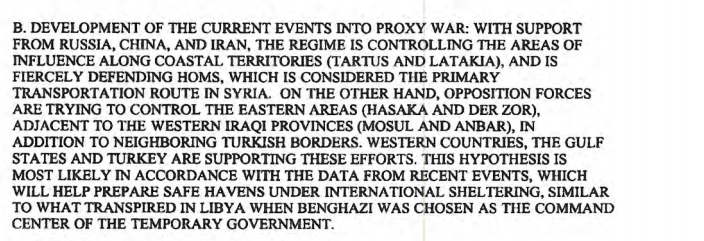In June 2015 Brookings Institution released a paper titled
Deconstructing Syria: Towards a regionalized strategy for a confederal country that detailed the policy that the U.S. should take in solving the Syrian crises that was unsurprisingly fomented by them. In this short post I will look at some of the key actions that was suggested and see whether they are being played out today.
In the introduction to the paper it mentions the overall strategy being:
The new approach would seek to
break the problem down in a number of localized components of the country, pursuing
regional stopgap solutions while envisioning ultimately a more confederal Syria made
up of autonomous zones rather than being ruled by a strong central government. It also
proposes a path to an intensified train and equip program. Once that program had
generated a critical mass of fighters in training locations abroad, it would move to a next
stage. Coupled with a U.S. willingness, in collaboration with regional partners, to help
defend local safe areas using American airpower as well as special forces support once
circumstances are conducive, the Syrian opposition fighters would then establish safe
zones in Syria that they would seek to expand and solidify.
At the time, this sort of solution seemed far fetched and ambitious, but we can see today that with the help of Russia, and "U.S. willingness" to this, they can indeed target those factions unfavourable to a permanent solution for Syria after Assad is deposed. It also serves in segregating the Islamic world further by smaller nations already divided on lines in the sand, to a more aggressive sectarian division that is not only based on culture, colour or language but on fundamental religious values and war.
The paper goes on to mention how the confederal arrangement for Syria could be merged using Kurdish region and Jordan:
The strategy would begin by establishing one or two zones in relatively promising
locations, such as the Kurdish northeast and perhaps in the country’s south near
Jordan, to see how well the concept could work and how fast momentum could be built
up. Over time, more might be created, if possible. Ultimately, and ideally, some of the
safe zones might merge together as key elements in a future confederal arrangement
for the Syrian state.
It is clear that without the support of Turkey and Jordan, these autonomous regions cannot be sustained and therefore they both will have a big role to play in dividing Syria, the report suggests:
Creation of these sanctuaries would produce autonomous zones that would never again
have to face the prospect of rule by either Assad or ISIL. They would also constitute
areas where humanitarian relief could be supplied, schools reopened, and larger
opposition fighting forces recruited, trained, and based. U.N. agencies and NGOs would
help in the effort to the extent possible, focusing on health, education, and basic
economic recovery in the first instance. Governing councils would be formed, more
likely by appointment than election, to help international agencies make decisions on
key matters relevant to rudimentary governance. Regardless of details, relief could
certainly be provided far more effectively than is the case today. At least one such area
should be contiguous to Jordan and one to Turkey, and be created in cooperation with
Amman and Ankara. These locations would allow secure transportation lines for
humanitarian as well as military supplies. They would also provide bases from which to
attack ISIL in its strongholds, a mission that western forces could carry out in
conjunction with local allies.
In the end, the Alawites will be given a zone whereby they can control, leaving Russia and Iran a part of the cake so that they take something away from this end-game.
The ultimate end-game for these zones would not have to be determined in advance.
The interim goal might be a confederal Syria, with several highly autonomous zones.
One of those zones might be for Alawites. But none could be for ISIL, al-Nusra, or
Assad and his inner circle
The report interestingly goes on to say what Russia and Iran get from this plan of action:
This strategy might soften the opposition to the basic approach by Iran and Russia as
well—perhaps reducing their inclination to escalate support for Assad and also possibly
even enlisting them in a future negotiated deal about Syria’s ultimate future. Indeed, the
strategy strikes a balance in its approach to Iran and Russia. It would grant neither a
major role. But it would seek to mitigate the risks of escalating rivalry with them by
holding out political hope and the prospect of an autonomous region for Alawites (even
those previously associated with the Assad regime, as long as they were not from his
inner circle). This approach may appeal even more to Moscow and Teheran to the
extent that battlefield dynamics go clearly against Assad in a sustained way, as they
have been already in the spring of 2015.
4 Damascus and Moscow would be much more
likely to support a confederal Syria to the extent they believe that the alternative had
probably become the complete overthrow of Assad and his government—and the
elimination of meaningful Alawite influence in a future government—or, in a best case,
protracted civil war of indefinite duration.
